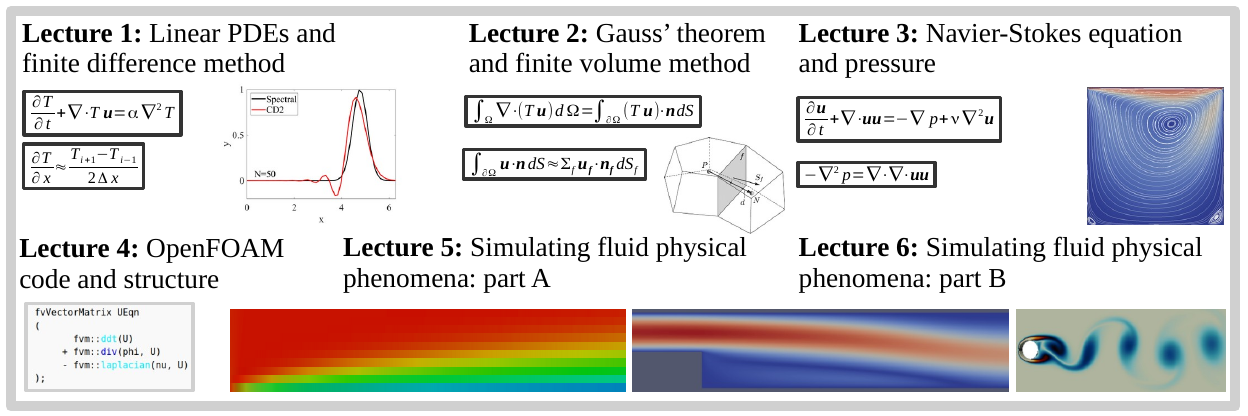EEN-E2001 - Computational Fluid Dynamics D, Lecture, 17.1.2022-5.4.2022
This course space end date is set to 05.04.2022 Search Courses: EEN-E2001
Översikt
-
Completion
The CFD course offers a first practical look into the OpenFOAM code, the largest open source CFD code in the world https://www.openfoam.com/ . On the present course, we focus on 2d laminar (transient) flows and basic methods to simulate such flows. Matlab will be used as well to complete small programs as part of final assignment. A graphical abstract of the course content is provided below.

Important to note: Each homework, even though only every other week returned, requires a significant amount of time usage (~1ECTS per HW). Carrying out the HW should be started more than a week before the DL. OpenFOAM user's forum and the course general discussion forums will be very fruitful sources to help you to reach course learning objectives (see below) faster.
To reach grade 4: the course is completed by solving 5 homework problems which are returned approximately every 2 weeks.
To reach grade 5: an additional (final) assignment is carried out. Via the final assignment, the students can carry out a small programming project (started on week 1 and largely supported during the course) to solve 1d transport problems.
Grade = 80% weighting on 5 HW and 20% weighting on final assignment + bonus
Bonus credits: During the course you will get bonus credits of max 0.5 grade units by participating in MyCourses discussion under General discussion. The bonus will be based on self-evaluation and our evaluation. It is a very important aspect to share information i.e. ask questions and provide answers. Main benefit of forum: you will save time via being active in the forum. Examples on getting bonuses: 1) post picture on some result and provide explanation (0.1 grade units), 2) pose a question and explain what you have tried to do + continue the discussion with others till a solution is found (0.1 grade units), 3) answer some question and provide some detail (e.g. a piece of advice, some bullet points) 0.1grade units, 4) answer some questions initiated by the course staff.
Course structure
Mondays: lecture to support reaching the course ILO's. The lecture has topics with relevance to HW theory questions. The lecture will support understanding the methods used in CFD, how different methods affect the CFD results and understanding the physical phenomena in computer assignments. Also, the lectures will be highly beneficial for the final assignment.
Tuesdays: computer class on HW. Every other week is "Part A" class where the aim is to make simulation case functional qualitatively. Every other week is "Part B" where the quantitative analysis is in focus including plotting pictures etc.
Intended learning objectivesILO 0 (OpenFOAM): The student can set up a 2d laminar transient flow simulation using OpenFOAM open source code. The student can validate the numerical solution against reference solutions including linear problems, boundary layer growth, vortex shedding and flow recirculation.ILO 1 (Governing equations and physics): The student can write the governing equations, boundary and initial conditions for an incompressible flow problem. The student can work with both index and vector notation. The student can explain the physics and phenomena behind the studied fluid flow systems.ILO 2 (Discretization – finite difference method): The student understands finite difference discretization method and can derive the difference formula and error terms from Taylor series. The student can choose diffusive/non-diffusive methods among different alternatives for governing equations.ILO 3 (Discretization – finite volume method): The student can use the Gauss' theorem to formulate a conservation law for each term of the governing equations. The student understands the link between control volume method and finite difference method. The student can derive the discretization error for a basic scheme on uniform grid.ILO4 (Discretization - matrix equations in CFD): The student can formulate matrix equations for linear equations discretized by finite differences. The student also understand the basics of solving linear equations Ax=b.ILO5 (Pressure correction method): The student can derive pressure correction method from the Navier-Stokes and continuity equations. The student understands why pressure correction method is needed and understands the idea of choosing numerical methods to solve pressure equation.ILO6 (Transient flow simulation): The student understands limitations of 2d flow analysis and understands how 3d simulations could be conducted. Also, the student gets an overview of different turbulence modeling approaches.ILO7 (final assignment) The student can write a 2d program in Matlab to simulate a time-dependent convection-diffusion equation and verify the code functionality. Return: animation and 3 page report.Recommended literature1) Course slides.2) C.Hirsch, Numerical Computations of Internal & External Flows, second edition, Elsevier (2007)3) OpenFOAM user manuals
